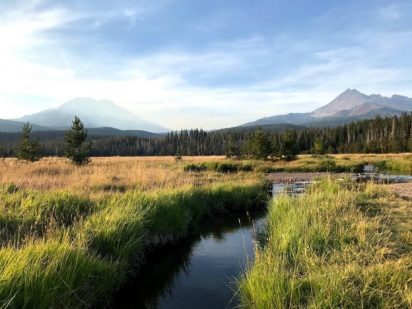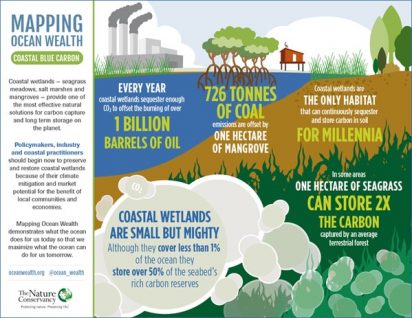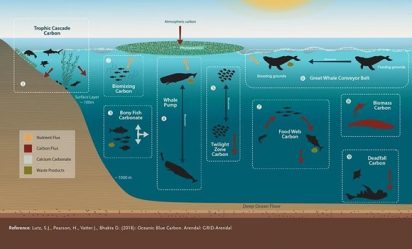Embracing blue carbon in regenerative natural resource practices
Over the span of human existence, many cultures around the globe have lived in relative stability with natural ecosystems, often cultivating their biodiversity and receiving sustenance from their richness. Can we envision a future where the dominant cultures around the planet again act as a beneficial species to the ecosystems that support us? How might human actions lead to cultures of permanence and stability by supporting the health of the planet’s climate and ecosystems? Historically, our oceans have often been seen as boundless reservoirs of resources and dumping grounds for waste. Perhaps the concept of blue carbon in this time of climate change can shift our perspective towards a regenerative relationship with the oceans that support global life.
Since the arrival of European settlers, much of the United States’ natural resource management practices have relied upon infrastructure and technology with a dominion-oriented vision. Models of this engineered approach abound throughout the nation. Rivers disconnected by dikes, levees, and dams, farmland tilled and fertilized until soil is impoverished, roads that obstruct wildlife passage, and coastal development supporting shoreline armoring are just several examples of short-sighted, control-based attempts to manage the land. As global ecosystems and wildlife populations buckle under the strain of climate change impacts and habitat degradation, the demand for an alternative approach to land and marine management becomes increasingly urgent.
This call for an alternative approach induces optimism because in many cases the most effective solution is also the simplest and cheapest. Ecosystems in their natural state are both resilient and brilliant, an insight that Indigenous peoples have respected and supported for tens of thousands of years. As an example, healthy floodplains provide natural flood solutions by connecting river systems and absorbing excess rainfall and groundwater, creating a rich habitat for economically, ecologically, and culturally significant species while combating climate change by sequestering carbon. Such ecologically productive systems are found throughout marine, coastal, and freshwater habitats.

The reality is that settler colonial attempts to manage the land to make it more habitable have resulted in ecosystems that struggle to support life. Assisting these systems in returning to a healthy state will facilitate countless benefits including reduced costs for structural implementation and upkeep, increased protection against natural disasters, increased food production, healthier water systems, more abundant wildlife, and reduced atmospheric and oceanic carbon.
Within the current model of US restoration efforts, segments of natural spaces are often removed from human interaction for conservation while extraction continues on remaining land and water resources. This approach results in a host of undesirable consequences, including fragmented ecosystems, decreased habitat productivity and resilience, widespread endangerment and extinction of species, displacement of Indigenous peoples, and a false dichotomy between humans and nature. A regenerative approach calls for a systemic shift away from natural resource management and towards a reciprocity approach that works in partnership with nature and is mutually beneficial for all living beings. Such a shift would prioritize ensuring land and water, including materials utilized for production and housing, is utilized in a sustainable, restorative, and life-fostering way. This is not a new approach for humans. Indeed, it has proven successful for human and more-than-human life since time immemorial. In our current climate crisis, a holistic, regenerative approach that returns to embracing the natural intelligence of ecosystems provides endless solutions to ensure a healthy future for human civilization.
Practitioners around the globe have been exploring these alternative approaches to natural resource management in efforts to combat climate change. Of growing interest in the marine affairs realm is blue carbon. Blue carbon refers to the immense capacity of aquatic systems to provide long-term carbon storage. By restoring, protecting, and stewarding coastal and marine ecosystems, the ocean is posed to provide some of the planet’s most powerful climate solutions.

The ocean is quite likely the site of life’s first flourishing on Earth. It plays a huge role in cycling the planet’s carbon and has helped maintain habitable temperatures on Earth for hundreds of millions of years. However, the ocean’s carbon-absorbing nature has resulted in ocean acidification and increased water temperatures as anthropogenic carbon emissions have followed a steep upward curve in recent decades. The ocean’s capacity to store carbon has allocated more time to respond to climate change in the short-term, but is ultimately limited and leading to the collapse of global marine ecosystems. Prioritizing models that support blue carbon in climate change adaptation and mitigation responses will support this climactic powerhouse in continuing to regulate our life-affirming atmosphere while combating carbon influxes, reducing ocean acidification and sea level rise, and reducing impacts from climate-related natural disasters. Blue carbon presents a powerful, comprehensive, and multi-benefit solution to the climate crisis.
In the Pacific Northwest, a good example of blue carbon is in the restoration and protection of kelp forests and seagrass meadows. These ecosystems are powerful sequesterers of carbon and provide habitat for many species that are integral to healthy marine and shoreline food systems. As the health of such ecosystems are prioritized, humans will experience cultural and economic gains such as healthier salmon runs. While impacts from climate change often lead to collapse in existing marine ecosystems, restoring a carbon-sequestering foundation species in aquatic systems can foster health throughout the food web. This is, in a sense, the opposite of a trophic cascade, a phenomenon scientists have witnessed far too often in terrestrial and marine ecosystems in recent years. In fostering healthy seagrass forests for example, we see an influx of life throughout the food chain in addition to the drawdown effects on carbon. Encouraging growth of such species can also support plastic alternatives and clean fossil fuels.

Kelp forests and seagrass meadows are just the beginning of the long list of aquatic ecosystems that have great carbon drawdown potential. Mangrove forests, coastal wetlands, floodplains, and bogs are just some of the naturally occurring systems that hold significant amounts of carbon and provide additional protections from climate change impacts. Mangroves, for instance, can store up to four times the amount of carbon that tropical rainforests can, and consequently release an equal amount into the atmosphere when they are removed. This highlights the importance of an additional benefit of storing carbon in marine ecosystems: their carbon will not be instantly released in the case of a wildfire, an increasing concern with the progression of climate change.
As we enhance the health of our oceans by restoring and protecting these ecosystems, we will see an increase in marine organism biomass. Recent research has investigated the key role that whales, for instance, play in combating climate change. Whale excrement facilitates growth of carbon-sequestering phytoplankton, and as a large and long-lived creature, they store substantial amounts of carbon in their bodies. Seaweed and shellfish farms exemplify human-managed contributions to blue carbon, and shellfish help filter water which is degraded by eutrophication as a co-benefit.

In recognizing the astronomical economic and cultural costs of fossil fuel-related disasters, embracing carbon sequestering restoration practices will provide powerful tools in the fight against climate change with myriad co-benefits throughout ecosystems. As an upcoming professional in marine resource management, it is exciting to continually learn about climate solutions that confront a wide spectrum of issues created by excess carbon emissions. There is no shortage of resource management practices that not only remove atmospheric and oceanic carbon, but also support biodiversity, provide coastal community protection, stabilize marine pH levels, enhance food sovereignty, create energy alternatives, and support environmental equity. Each of these natural climate solutions can be cost-effective and can actually contribute to global wealth when considering the ‘social cost of carbon.’ These economic advantages can help establish political palatability of nature-based solutions to climate change. Humans have a wealth of options to choose from as we move into a future that is more aligned with sustained life for all.